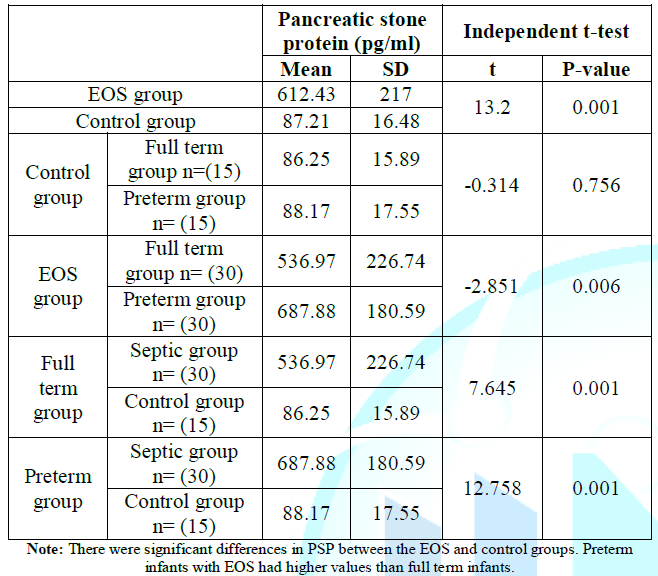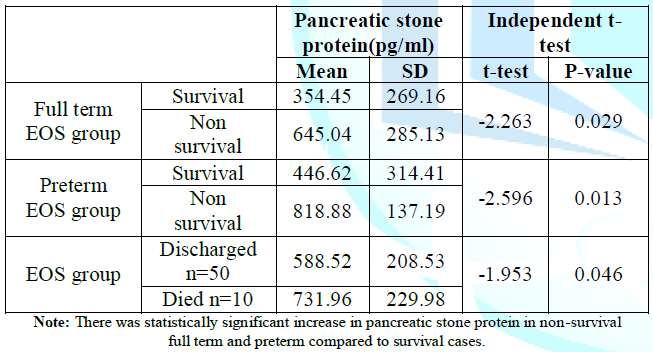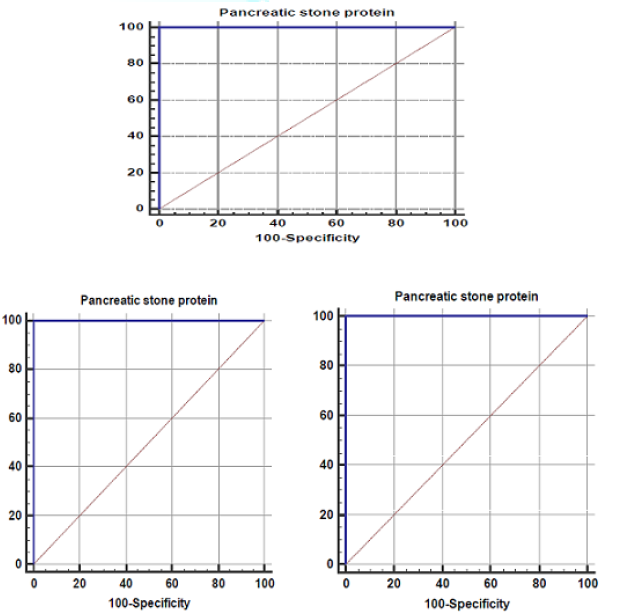Introduction
Neonatal sepsis is a common, devastating, and overwhelming disease that contributes to morbidity and death. It has life-long impact plagued by a lack of accurate diagnostic and prognostic testing [1]. The clinical signs are non-specific and indistinguishable from those caused by a diversity of neonatal noninfectious disorders. Early detection and diagnosis of neonatal sepsis is difficult but extremely important because prompt institution of antimicrobial therapy improves outcomes.
Early-Onset Sepsis (EOS) is one of the major reasons for the neonatal admission in Neonatal Intensive Care Unit (NICU). EOS has been variably defined based on the age at onset, with bacteremia or bacterial meningitis occurring during 72 hours in infants hospitalized in the NICU [2]. Neonatal early-onest sepsis occurs in the following criteria newborns with early-onset sepsis, 85% present within 24 hours, 5% present at 24-48 hours, and a smaller percentage presents within 48-72 hours. Onset is most rapid in premature neonates [3]. Although of the constant efforts to diagnose neonatal sepsis still it persist a perplexing topic for neonatologists due to multiple factors including the lack of ideal diagnostic markers that fit both full- term and preterm infants. Pancreatic Stone Protein (PSP) is a protein secreted by the pancreas recognized by varied scale of functions, as adhesion and signaling receptors in homeostasis and innate immunity, it is vital in inflammatory process and leukocyte and platelet trafficking.
Moreover, the observation that PSP level rose in response to septic insults in mice and rats encouraged its clinical evaluation as biomarker of sepsis in various settings and conditions [4]. PSP has recently emerged as a promising sepsis marker in adults, with high PSP levels predicting sepsis, sepsis associated multiple-organ failure, in patients with ventilator-associated pneumonia, post-traumatic sepsis and mortality. Few consistent data are available for PSP in the clinical setting of neonatal sepsis [5-7].
Our research question was can Pancreatic stone protein be used as novel marker for diagnosis of early onset sepsis in neonatal population?
Objective
The objective of this study was to assess the value of PSP as a novel sepsis biomarker in diagnosis of early onset neonatal sepsis.
Patient and Methods
Study design
This study was a case-control study. It was conducted in the NICU of Al-Zahraa University Hospital. The study included 90 newborn infants, who were allocated into 2 groups, group 1 with EOS (n=60) and group 2 control, apparently healthy newborn infants with no risk factors or clinical manifestations of sepsis (n=30). Inclusion criteria for the study group were diagnosis of early onset sepsis in the first 72 hours after birth, with the “presence of at least two clinical symptoms and at least two laboratory signs in presence of or as a result of suspected or proven infection (positive culture, or microscopy polymerase chain reaction)” as suggested by report on the expert meeting on neonatal and pediatric sepsis 2010 [8]. Diagnosis of cases with negative blood culture was based upon the clinical sepsis and hematological scores.
In this study full term infants were those >37 weeks of gestation and preterm infants (32-34) weeks. Exclusion criteria included newborn infants with congenital anomalies, chromosomal abnormalities or inborn errors of metabolism, confirmed intrauterine viral infection, perinatal asphyxia. Neonates receiving parenteral antibiotic at the time of sepsis evaluation or newborn had just undergone surgery.
Procedure
All neonates were subjected to history taking, clinical examination, laboratory investigations including: Complete Blood Count (CBC), liver and kidney function tests, blood culture, C-Reactive Protein (CRP), and serum pancreatic stone protein using Enzyme-Linked Immunosorbent Assay (ELISA), kits from Kono Biotech Co.,Ltd, catalogue number: KN 2065Hu (My Biosource/MBS285689, San Diego, California, USA). Clinical sepsis score according to Töllner score was done, as well as the hematological score [9,10]. Samples were collected at the time of diagnosis of sepsis. The study was approved by the ethics committee of the scientific research, Faculty of Medicine for girls, AL-Azhar University. An informed consent was obtained from the parents or caregivers of each neonate before enrollment in the study.
Statistical analysis
Data were collected, coded, revised and entered to the statistical package for social science (IBM SPSS) version 20.
Results
The results are shown in Tables 1- 4.

Table 1: Clinical characteristics of the studied newborn infants.
Discussion
PSP has been studied in adults and shown to accurately predict multi-organ failure and mortality in patients with ventilator-associated pneumonia and post traumatic sepsis [5,6]. This study analyzed the role of PSP as a novel sepsis biomarker in diagnosis of early onset neonatal sepsis in newborn infants. There was no significant difference in gestational age between EOS group and control group. There was predominance of male gender (60%) among the sepsis group. The present study showed significant decrease in Apgar score among sepsis group at 1-5 minutes. Töllner score was higher among sepsis group than the control group. The current study results showed the importance of PSP as novel sepsis marker in diagnosis of early onset neonatal sepsis as well as its prognostic values. The mean values PSP was increased statistically in ESO group in comparison to control group (P=<0.001). This increase among the sepsis group may be due to promoting cellular proliferative responses in the pancreas by PSP and activation of polymorph nuclear cells, PSP/reg binds and activates neutrophils behaving as an acute-phase protein that responds to injury during the early phase of infection [5].
Animal studies have shown induction of PSP expression in subset of intestinal and gastric cells by stress conditions in absence of direct pancreatic inflammation [8,11]. In this study, PSP at a cutoff value of >133.8 pg/ml, had the sensitivity, specificity, Positive Predictive Values (PPV) and Negative Predictive Values (NPV) of 100%, and the Area Under Curve (AUC) was 1.000 (𝑝 < 0.001) for the EOS group, this results are more or less the same as those of Rass et al. who reported that at a cutoff level of 12.96 mg/mL, the sensitivity was 96.2%, the specificity was 88.5%, PPV value was 95.8%, NPV was 89.3%, and AUC was 0.87 and to Schlapbach, et al. who reported that PSP has high NPV of 90% and 79% sensitivity in newborn infants, also to results by Wu, et al. who reported sensitivity of 79.7% in pediatrics patient. Also Dima, et al. found that the diagnostic performance of PSP was superior to that of traditional markers [7,12-14]. Further analysis of the data for the preterm infants (32-34) weeks, showed 100% sensitivity, specificity as well as PPV and NPP at a cut off value of >125.6 pg/ml.

Table 2: Pancreatic stone proteins in the studied groups.

Table 3: Pancreatic stone proteins and neonatal outcome.
There was significant increase in PSP mean values in preterm infants with EOS in comparison to full term infants (P=0.006). It could be due to systemic exaggerated immature inflammatory response to invasive bacteria and significant stress among the studied preterm infants. Schlapbach, et al. reported that PSP has bell-shaped distribution from birth to adulthood in normal population, this is opposite to the results of current study [15]. On the other hand, Stoll et al. stated that the risk of early onset sepsis increases with decrease of gestational age because of the inability of white blood cells to carry out phagocytosis, immaturity of the immune system, low complement levels, and hypogammaglobulinemia [16]. As far as we know this study was first to look at PSP in full term and preterm infants. To understand the exact mechanism, it may need further larger study.
In practice, different thresholds for PSP may be needed to detect severity of illness in newborns compared to older age groups. So this study looked also at the differences of PSP between the survival and non-survival cases. There was statistically significant increase in PSP in non-survival EOS group weather preterm or full term than those survival cases of EOS group (P=0.046). The increase in PSP could be due to additional stress and severity of inflammation among severely sick dead cases that led to expression of more PSP, also metabolic disturbances and respiratory failure lead to acidosis, which can increase expression of PSP [15].

Previous studies showed significant PSP increase in presence of significant stress and multi-organ dysfunction syndrome in critically ill children and patients who died [17]. These findings agree with those of Que, et al. who found that risk of mortality in adult population increased continuously for each ascending quartile of PSP in a prospective cohort of patients with sepsis requiring (Intensive care unit) ICU management [18].

In the current study, there was no significant correlation between CRP and PSP in EOS group. In earlier study we showed that CRP had initial low sensitivity 75%, specificity 33%, PPV 83% and NPV 24%, during the early phases of infection, hence it is unhelpful in the initial diagnosis of EOS [19]. Serial determinations improve the diagnostic accuracy and are useful for evaluating the response to treatment. CRP considered as a “specific” but “late” marker of neonatal infection. The best predictive ability of CRP for EOS lies when it is measured within 24-48 hours of birth or a rising CRP level is seen [20].
These results attach with those of Schlapbach, et al. who revealed that the performance of PSP was comparable or superior to other markers such as CRP, PCT or soluble Human Triggering Receptor Expressed on Myeloid Cells-1 (sTREM-1), suggesting PSP is independently increased in presence of infections. The PSP is a rapid laboratory test (<1.3h) and require minimal blood volume (<50 𝜇L) [7]. PSP is more sensitive, specific and has a good negative predictive value compared to CRP confirming its value as marker to rule out early onset neonatal sepsis.
In the present study PSP did not increase from postnatal age day 1 to day 3 in the EOS groups (P=0.806), Schlapbach, et al. observed a slow increase in PSP concentrations over the first days of life [15]. Also there was no significant difference in mean values of PSP in relation to gender in the studied groups. This study showed significant correlation of PSP with clinical Töllner score and hematological score. This may strengthen the rule of clinical sepsis score and hematological score in diagnosis of sepsis in limited resources countries. PSP can safely guide the decision to initiate empirical antibiotic treatment in infants with suspected EOS. Errors related to use of anti-infective drugs was reported in 83.4% of a study done by ELMeneza, et al [21]. Finally, the present study revealed that PSP is valuable in both diagnosis and prognosis of neonatal sepsis.
The limitations of this study include the relatively small sample size resulting inability to explain the significant increase of PSP in preterm infants than full term infants with EOS. In conclusion, our findings advocate that role of PSP as a valuable marker in diagnosis of neonatal EOS. PSP has high sensitivity and specificity, it may empower the neonatologist for safe care and judicious use of antibiotic. PSP may assist in distinguishing the serious cases that may have bad prognosis.
Recommendation
PSP can be used as a new marker for diagnosis of early onset sepsis. Further study should be conducted with larger number of neonates to confirm PSP values in early diagnosis and prognosis of neonatal sepsis especially among preterm and very low birth weight infants.
Statement of Ethics
The parents have given their informed consent and the study protocol was approved by the Faculty of Medicine for Girls ethical committee.
References
1. James L Wynn. Defining neonatal sepsis (2016) Curr Opin Pediatr 28: 135-140.
2. Edwards MS. Postnatal infections. In: Neonatal-Perinatal Medicine, Fanaroff and Martins (Eds) (2012) Mosby Elsevier, USA 791-804.
3. Klinger G, Levy I, Sirota L, BoykoV, Reichman B, et al. Epidemiology and risk factors for early onset sepsis among very-low-birthweight infants (2009) Am J Obstet Gynecol 201: 38.e1-38.e6. https://doi.org/10.1016/j.ajog.2009.03.006
4. Philippe E, Yok-Ai Q and Fabien R. Measurement of pancreatic stone protein in the identification and management of sepsis (2019) Biomark Med 13: 135-145. https://doi.org/10.2217/bmm-2018-0194
5. Keel M, Harter L, Reding T, Sun L, Hersberger M, et al. Pancreatic stone protein is highly increased during posttraumatic sepsis and activates neutrophil granulocytes (2009) Critical Care Medicine 37: 1642-1648. https://doi.org/10.1097/ccm.0b013e31819da7d6
6. Boeck L, Graf R, Eggimann P, Pargger H, Raptis D, et al. Pancreatic stone protein: a marker of organ failure and outcome in ventilator-associated pneumonia (2011) Chest 140: 925-932. https://doi.org/10.1378/chest.11-0018
7. Schlapbach LJ, Graf R, Woerner A, Fontana M, Zimmermann-B U, et al. Pancreatic stone protein as a novel marker for neonatal sepsis (2013) Intensive Care Medicine 39: 754-763. https://doi.org/10.1007/s00134-012-2798-3
8. Rossi P and Botgros R. Report on the Expert Meeting on Neonatal and Paediatric Sepsis (2010) European Medicine Agency, UK.
9. Töllner U. Clinical studies and sepsis score (1982) European J Pediatrics 138: 331-337.
10. Pramana KP, Kardana M and Putu GA. Diagnosis Accuracy of Hematological Scoring System in Early Identification of Neonatal Sepsis (2016) Bali Med J 5: 139-144. https://doi.org/10.15562/bmj.v5i3.310
11. Graf R, Schiesser M, Reding T, Appenzeller P, Sun LK, et al. Exocrine meets endocrine: pancreatic stone protein and regenerating protein-two sides of the same coin (2006) J Surg Res 133: 113-120. https://doi.org/10.1016/j.jss.2005.09.030
12. Rass AA, Talat MA, Arafa MA, Mohamed A, Anwar A, et al. The role of pancreatic stone protein in diagnosis of early onset neonatal sepsis (2016) BioMed Res Int 2016: 1-8. https://doi.org/10.1155/2016/1035856
13. Wu R, Zha L, Hu JH, Wu JM and Tian ZF. The value of pancreatic stone protein in the prediction of infected neonates (2017) Minerva Pediatr 69: 489-494.
14. Dima M, Iacob D, Marginean O and Iacob ER. New emerging biological markers of neonatal sepsis (2017) J Res Med Sci 22: 65. https://doi.org/10.4103/jrms.jrms_912_15
15. Schlapbach LJ, Giannoni E, Wellmann S, Stocker M, Ammann RA, et al. Normal values for pancreatic stone protein in different age groups (2015) BMC Anesthesiology 15: 168. https://doi.org/10.1186/s12871-015-0149-y
16. Stoll BJ, Hansen NI, Sánchez PJ, Faix RG, Poindexter BB, et al. National institute of child health and human development neonatal research network early onset neonatal sepsis: the burden of group B streptococcal and E. coli disease continues (2011) Pediatrics 127: 817-826. https://doi.org/10.1542/peds.2010-2217
17. Jiri Z, Kyr M, Vavrina M and Fedora M. Pancreatic stone protein-a possible biomarker of multiorgan failure and mortality in children sepsis (2014) Cytokine 66: 106-111. https://doi.org/10.1016/j.cyto.2014.01.009
18. Que YA, Delodder F, Guessous I, Graf R, Bain M, et al. Pancreatic stone protein as an early biomarker predicting mortality in a prospective cohort of patients with sepsis requiring ICU management (2012) Critical Care 16: R114. https://doi.org/10.1186/cc11406
19. ELMeneza SA, Esmail HO, Elbagoury EM and Abd Allah NA. Soluble triggering receptors expressed on myeloid cell-1 and proadrenomedullin for diagnosis and prognosis of early onset neonatal sepsis (2018) EC Paediatrics 7: 619-628.
20. Hofer N, Zacharias E, Müller W and Resch B. An update on the use of C-reactive protein in early-onset neonatal sepsis: current insights and new tasks (2012) Neonatology 102: 25-36. https://doi.org/10.1159/000336629
21. EL Meneza S, Habib A and Abd ElSalam RM. Analysis and identifying risk profile for medication errors in the neonatal intensive care units (2018) EC Paediatrics 7: 669-684.
*Corresponding author
Safaa ELMeneza, Pediatrics department, Faculty of Medicine for Girls, AL-Azhar University, Egypt, Email: safaa5@hotmail.com
Citation
ELMeneza S, Fouad R and El Bagoury I. Pancreatic stone protein as a novel marker for early onset neonatal sepsis (2019) Edelweiss Pediatrics J 1: 1-4
Keywords
Early neonatal period, Neonatal sepsis, Newborn infant, Preterm, Neonatal Outcome, Pancreatic Stone Protein, Sepsis.


 PDF
PDF